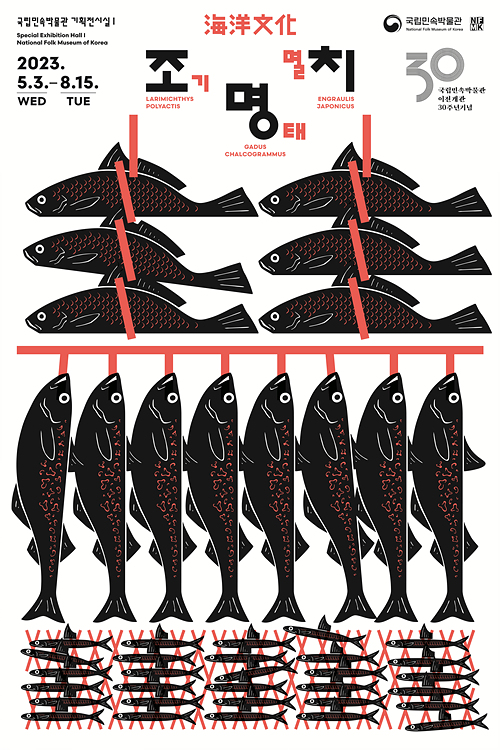Exhibitions
| Title | 조명치 해양문화특별전 (Croaker, Pollock, and Anchovy) | ||||||||||||||||||||||||
|---|---|---|---|---|---|---|---|---|---|---|---|---|---|---|---|---|---|---|---|---|---|---|---|---|---|
| Period | May 3 2023 - August 15 2023 | ||||||||||||||||||||||||
| Venue | Special Exhibition Hall I (NFMK Seoul) | ||||||||||||||||||||||||
|
 EXHIBITION OUTLINEDid you know that Korea is the world’s number one seafood consumer per capita? AS Koreans who are serious about seafood, croakers, pollocks, and anchovies are our “favorite” fish. We are even willing to travel as far as Africa in order to import fish that taste and look like croaker. Pollock always makes the top of our list of favorite imported seafood, but a Korean’s love for anchovies is far more remarkable. Korea proudly marks itself as the world’s number one consumer of anchovies. What makes these fish so important that we can’t imagine a table without them? This exhibition introduces each fish; details regarding how they are caught, processed, distributed, and sold before reaching our tables; as well as how they are related to our daily lives. We invite you to listen to the stories of the croakers that croak like the frogs, the pollock whose eyes are so big they can supposedly see 10,000 miles away, and the anchovies with their shining silver color. This is an opportunity to listen to what the Korean fish have to say! We invite you to be pleasantly surprised by that which is usually taken for granted, because it has always been around.
Part.1 CROAKER, POLLOCK, AND ANCHOVY ON THE TABLECroaker, pollock, and anchovy have had an immense impact on Korean food culture. Delicious side dishes, usually eaten with rice, are often affectionately called “rice thieves” referring to the way food seems to practically disappear as if stolen. Still, this does not do justice to their place in the Korean diet. Taste contains information which can be acquired culturally, and cultural factors vary from society to society. Therefore taste is simultaneously an individual and collective experience.
Part.2 CROAKER, POLLOCK, AND ANCHOVY THAT CAME UP TO THE LANDThis section tells the stories of people whose livelihood depends on croakers, pollocks, and anchovies, including those working at pollock-drying facilities and auctioneers and middlemen at consignment markets. Our table is kept full by the hard work of numerous people. Procedures relating to the sale, distribution, and processing of fish in the past and present are shown here. Examples include fish markets and shops, consignment markets, and pasi (seasonal fish markets).
Part.3 SEA OF CROAKER, POLLOCK, AND ANCHOVYCroakers, pollocks, and anchovies are migratory fish that return to the seas adjoining the Korean Peninsula when the season comes. Pollocks are cold-current fish, while croakers and anchovies are a warm-current species. Since they appear in large schools at a certain period, they require a large number of fishing boats and an ample fishing crew for concentrated fishing. It is more labor intensive than fishing for resident species that settle in one place such as seabream and spotty belly greenlings.
|
|||||||||||||||||||||||||
| Date | 2023-05-25 | ||||||||||||||||||||||||
| 이전글 | Here Comes a Rabbit |
|---|---|
| 다음글 | Najeon, Glimmer & Shine |














